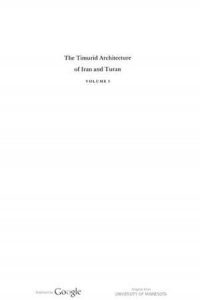نام کتاب: The Timurid Architecture Of Iran And Turan
نویسنده: Lisa Golombek و Donald Newton Wilber و Terry Allen
ویرایش: ۱
سال انتشار:
کد ISBN کتاب: ,
فرمت: PDF
تعداد صفحه: ۸۴۸
حجم کتاب: ۸۷ مگابایت
کیفیت کتاب: OCR
انتشارات:
Description About Book The Timurid Architecture Of Iran And Turan From Amazon
An upsurge of interest in Islamic art and architecture creates the ideal climate for publication of this long-awaited comprehensive picture of the entire range of building activity sponsored by the Timurids during the fifteenth century, including the monumental, color-clad mosques, shrines, and mausoleums. The term “Timurid” here refers not only to the empire established by Timur around 1370, but also to that of his successors and their rivals who shared in an extraordinary cultural flowering stretching from Iran throughout Turan, north of the Amu Darya River. In the interpretative essays that make up about half the first volume, Lisa Golombek and Donald Wilber discuss this mature culture and highlight the major architectural achievements of the age. Following the essays is an extensive catalogue of 257 Timurid monuments, based on field investigations by the authors and others and on original sources still inaccessible to most scholars. In addition, the authors have developed a new descriptive and critical vocabulary that will be useful not only for this period but for the study of the architecture of Mogul India, Safavid Iran, and, by extension, of the Ottoman Empire. The catalogue contains contributions by Terry Allen, Leonid S. Bretanitskii, Robert Hillenbrand, Renta Holod, Antony Hutt, L. Iu. Man’kovskaia, and Bernard O’Kane. The second volume contains the illustrations. A distinctive feature of this study is its treatment of general architectural questions, such as the uses of geometry, spatial and decorative characteristics, and construction techniques.
درباره کتاب The Timurid Architecture Of Iran And Turan ترجمه شده از گوگل
افزایش علاقه به هنر و معماری اسلامی ، فضای مطلوبی را برای انتشار این تصویر جامع مدتها در انتظار کامل فعالیتهای ساختمانی تحت حمایت تیموریان در طول قرن پانزدهم ، از جمله مساجد ، عبادتگاهها و عبادتگاههای رنگی پوشانده است. مقبره اصطلاح “تیموری” در اینجا نه تنها به امپراطوری که تیمور در حدود سال ۱۳۷۰ تأسیس کرد ، بلکه همچنین به جانشینان وی و رقبای آنها اشاره دارد که در یک شکوفه شکوفائی فرهنگی خارق العاده از ایران در سراسر توران ، شمال رودخانه آمو دریا زندگی می کنند. در مقاله های تفسیری که حدود نیمی از جلد اول را تشکیل می دهد ، لیزا گولومبک و دونالد ویلبر در مورد این فرهنگ بالغ بحث کرده و دستاوردهای عمده معماری عصر را برجسته می کنند. به دنبال مقالات ، فهرست گسترده ای از ۲۵۷ بنای تاریخی تیموری ، بر اساس تحقیقات میدانی توسط نویسندهو دیگران و منابع اصلی که هنوز برای اکثر محققان غیرقابل دسترسی است ، تهیه شده است. علاوه بر این ، نویسندهواژگان توصیفی و انتقادی جدیدی را ایجاد کرده اند که نه تنها برای این دوره بلکه برای مطالعه معماری مغول هند ، ایران صفوی و به طور گسترده امپراتوری عثمانی مفید خواهد بود. این کاتالوگ شامل همکاری های تری آلن ، لئونید اس. برتانیتسکی ، رابرت هیلنبراند ، رنتا هولود ، آنتونی هوت ، ال. آیو است. مانکوفسایا ، و برنارد اوکان. جلد دوم شامل تصاویر است. از ویژگی های بارز این مطالعه ، درمان آن با س questionsالات معماری عمومی ، مانند استفاده از هندسه ، ویژگی های مکانی و تزئینی و تکنیک های ساخت است.
[box type=”info”]![]() جهت دسترسی به توضیحات این کتاب در Amazon اینجا کلیک کنید.
جهت دسترسی به توضیحات این کتاب در Amazon اینجا کلیک کنید.![]() در صورت خراب بودن لینک کتاب، در قسمت نظرات همین مطلب گزارش دهید.
در صورت خراب بودن لینک کتاب، در قسمت نظرات همین مطلب گزارش دهید.

